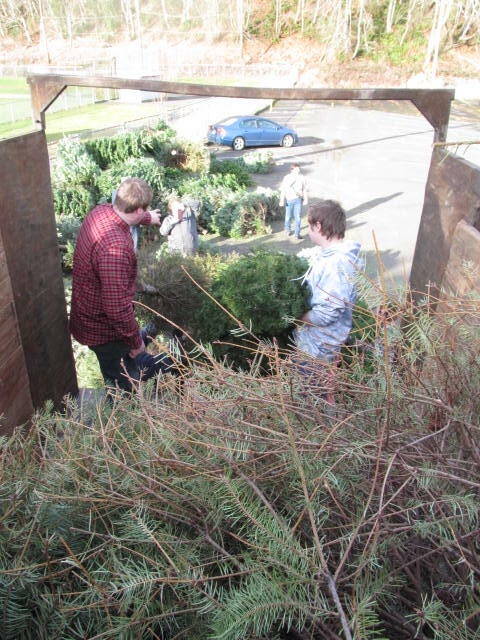The Christmas spirit has kept Dan Boeholt’s property from falling into the river for a quarter century.
The outdoor enthusiast found the evergreen trees that people stand in their living rooms and dress with bulbs, popcorn and candy canes during December can be recycled as a natural solution to riverbank erosion.
Only after the tinsel is removed, of course.
This season, Boeholt is continuing his tree-gathering tradition with help from the community, and a bunch of Boy Scouts.
From 10 a.m. to 3 p.m. on Jan. 6, 7 and 13, Hoquiam Boy Scout Troop 100 will be stationed at the old Washington Elementary School in Hoquiam, 3003 Cherry St., to help offload leftover Christmas trees. The public is encouraged to drop off their trees, which Boeholt will haul to his property on the North River in Pacific County.
The project not only protects Boeholt’s property from surging river waters, but also satisfies the Scouts’ mission of service, said Danny Hall, who leads the nonprofit Rainy City Scouts, a group that helps develop Boy Scout programs locally.
“One of the big focuses of scouting is service,” Hall said. “We’re here to serve others, we’re here to serve our communities, we’re here to serve nature. We’re supposed to be good stewards, and that’s what we’re teaching these kids.”
Hall said he is also working with a troop and Cub Scout pack in Elma to help collect trees there.
Hall said he’s worked with a few other troops in the past that have done Christmas tree collections, but none that were devoted to riverbank restoration.
When Boeholt first bought property on the North River, winter rain runoff and high flows were shearing chunks of dirt and mud away from the riverbank, threatening his future homesite. After consulting with several agencies, Boeholt said, many of the project options carried high costs or required complex permits. He didn’t like the idea of armoring the bank with rocks or riprap.
“I’ve spent all my life in the outdoors and I’d see trees fall — the root wad stay up on the ground and then the top falls down, it catches all the sediment and makes big holes for fish. So I kept trying to come up with a way to do that.”
Then he saw a newspaper article about a Leavenworth man who reinforced the banks of the Icicle River with unsold Christmas trees.
In his first year, Boeholt said, the Scouts helped him gather more than 1,000 Christmas trees, which he piled on his property to work on the project throughout the year. Before the COVID pandemic, Scouts used to go door to door to collect the trees. They usually collect hundreds of trees each year, he said.
Boeholt said he’s used a variety of recycled materials to bind and fasten the trees together over the years, including twine, recycled wire and leftover bolts from a 1960s construction project on the Simpson Avenue Bridge.
Boeholt said the needles of the trees on his banks act as a strainer for passing sediments, piling up river deposits and ultimately covering the trees.
That power of recycled Christmas trees, which might otherwise end up in a landfill, has been employed by parishes in Louisiana to help reduce wetland erosion, and explored on the East Coast to help build sand dunes.
Boeholt sees Christmas trees as a big part of the future of shoreline resilience in Southwest Washington.
“I just encourage everybody to do a little bit and help, help with our riverbanks help with our fish habitat,” Boeholt said.
Contact reporter Clayton Franke at 406-552-3917 or clayton.franke@thedailyworld.com.


